

One of the greatest beauties of the age, Margaret, Countess of Blessington (Sir Thomas Lawrence, 1822).
JANE AUSTEN visited Carlton House on 13 November 1815 when the Prince Regent gave her the honour of allowing her to dedicate her latest novel Emma to him. She must have given considerable thought to what she wore that day but unfortunately did not discuss it in her letters. The librarian of Carlton House, the Reverend James Stanier Clarke greeted her with due ceremony as a fellow author and gave her a tour of the Prince’s extravagant home. It seems she made quite an impression on him as they struck up a relationship via letter. He also painted a watercolour of her in his ‘Friendship Book’ depicting her wearing a white muslin gown with a stole-like cloak of black with red, a matching hat of black velvet with red trim, red shoes and brown fur muff. Jane was less impressed, ambivalent about how she should dedicate the work, and very disapproving of the Prince’s excessively lavish lifestyle, especially at a time when the country was plunged into recession.
Her thoughts would be echoed by many others before the end of the decade. The ‘age of elegance’ was slipping away; in 1816 Byron left England in disgrace, Beau Brummell fled to France to escape his debts, and Jane Austen became increasingly ill with what is thought to have been Addison’s disease. The royal wedding on 2 May 1816 saw all hopes rest on Princess Charlotte, the plump and happy girl who pleased the nation by preferring only English gowns. She also enjoyed Jane’s works, particularly Sense and Sensibility, saying:
I think Maryanne & me are very like in disposition, that certainly I am not so good, the same imprudence, &c, however remain very like. I must say it interested me much.
Revolution had changed the world and fashion had dressed it accordingly. The war had been the main impetus for the last twenty-three years, introducing new ideas and new cultures, each reflected in what was worn. The textile industry had been affected exponentially, developing new processes to provide fashions that had formerly been imported, and to supply massive orders for military uniforms, but the cost to the workforce had been high. Despite proving England’s pre-eminence, the post-Waterloo attitude was one of dour sobriety for all except the Prince’s court. They partied on, unaffected by the small groups of heroes, once splendid, their red or blue now ragged, who were left begging by the roadside by the authorities who refused to pay the wages that were owed to them for years of service.
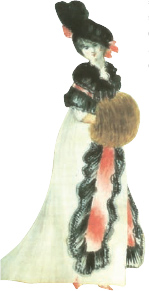
Portrait of Jane Austen by the Reverend James Stanier Clarke from his ‘Friendship Book’ painted in 1815 after they met on her visit to Carlton House.
Aristocratic and genteel ladies set up societies to raise money for Waterloo widows and the Waterloo wounded, but gone were the days when beautiful political patrons would have been able to exert a little influence directly. Men and women were becoming polarised: once men had realised the comfort and camaraderie of their own company they were less keen to adopt the ‘full dress’ and fine manners necessary for female society. Women lost any freedoms they may have gained with the rise of evangelicalism and sentimentality, when it was remembered that women were ‘inherently sinful’ and the only way they could redeem themselves was through a life of modesty, sobriety, charity and silence.
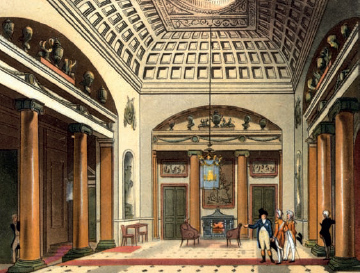
Carlton House as it was in about 1808.
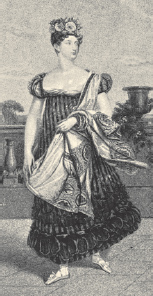
Princess Charlotte of Wales in 1816 looking elegant in striped gown with luxurious luxurious Paisley shawl.
Men had chosen to make the Great Renunciation, giving up fine fabrics, decoration and even colour to create the convention of the business suit, but in exchange they gained a new world of business and industry crowned with a top hat. For women the renunciation was enforced by a strict moral opprobrium that stripped away the idealism that had been so carefully represented through dress, replacing it with a facile submissive prettiness. The waist was gradually restored to its natural position and laced tighter than ever, whilst further encumbrance was added as sleeves grew wider, hems gained width and heavy decoration, and bonnets became blinkers to the world.
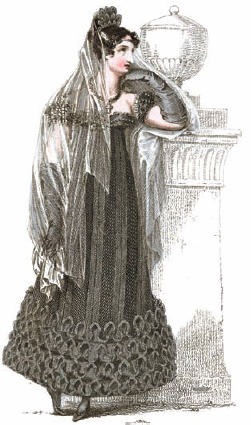
‘Evening Dress for Mourning’ (Ackermann’s Repository, December 1817). The nation was plunged into mourning when Princess Charlotte died in childbirth on 6 November 1817. Mourning was observed for royalty as well as even the most distant family members, but the expense of buying special mourning clothes would sometimes mar the sentiment.
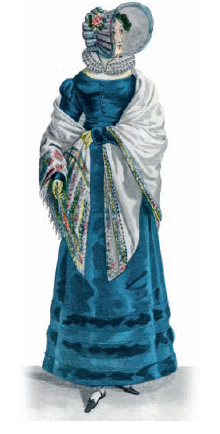
Deep blue dress with ruff and shawl, 1819. The days of girlish freedom were over as women would soon have to cope with the enforced concealment of poke bonnets and an ever-narrowing waistline demanded by corsets even more cruel than their eighteenth-century predecessors.